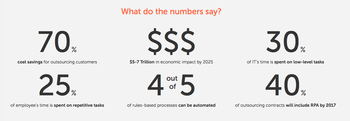Robotics: Threat or Opportunity for Asia’s Low-cost Centers?
Add bookmarkWith robots all the rage, conventional thinking has it that the impact on Asia’s shared services and BPO centers will be one of replacing busy hives of activity employing thousands of people, with row upon row of gleaming, silent [and deadly] robotic processors.
Not so fast. While the impact of robotic automation on transactional activities is enormously significant, in truth, it represents nothing more than a continuous evolution as a result of emerging technology. What cannot now, nor ever, be replaced is the inimitable human touch.
It’s also important to remember that in the greater scheme, the emergence of non-human services can present a much-needed solution to an otherwise insurmountable problem. In Thailand, for example, CT Asia’s "Dinsow" robot is one example of an application that is filling the gap in much-needed nurse resources to care for the elderly. But although the company’s founder’s vision of "a robot in every house" is some time off, "a robot in every business" is highly feasible.
At the last industry event I attended, Shared Services and Outsourcing Week Europe, it was patently obvious that robotic technology is increasingly being adopted by shared services, but that, far from eliminating employees, the human element was going to be taking a leading role. This was reinforced by one of the keynote speakers – digital strategist and FT columnist Ade McCormack – who reminded us that technology can only go so far. Where it stops, people, and increasingly, the more creative types, need to move the customer service experience forward.
McCormack spoke about "value" in the digital economy in terms of the digital, macroeconomic and anthropological trends that are reinventing the workplace today. And while the numbers in favour of process automation are sobering and exciting, at the same time (see below) there is no reason to worry about downsizing your FTEs just yet.
Source: Automation Anywhere [click to enlarge]
Here are five reasons robots will not be replacing Rahul or Rheya just yet, although the current services delivery model will of necessity be shifting.
1. Interpreting Process Data
While robotics shifts the formula for "doing" the work, clients are now demanding new and different outputs from their service providers. This includes, most certainly, the kind of data analytics and business intelligence that has until now been buried deep within process data. Interpreting these numbers and prescribing as well as predicting their impact on the business will remain a human service for the foreseeable future. So while we may see less keying in, we can expect more keying out in terms of value-add reporting.
2. Engaging with Management
In enterprises where shared services have become established and recognized as a valuable resource, senior management is relying on the SSO's ability to support organizational growth and success. This means developing relationships with the senior team, being recognized as a trustworthy source of intelligence as well as ideas, and taking a seat at the strategic table when it comes to making decisions. Only humans need apply.
3. Understanding the Restrictions and Requirements of Local Business
Many attempts at standardization as part of regional or even global business services models have floundered in the face of local resistance. Whether as a result of local regulations, conventions, or language, this is not an issue easily resolved. Here too, while transactions may be automated, the relationship management element cannot and will not fade away. On the contrary, with better process data at their fingertips, chances are that relationship managers will take a more collaborative approach to servicing the business. A win-win for all.
4. Managing Careers Remains, Well, Personal
A top complaint for HR managers is that their staff are weighed down by administrative duties and are unable to offer the kind of proactive support that businesses require to compete and succeed. This is where HR management automation is a true gift. The ability to better manage the bevy of administrative tasks through automating payroll benefits admin, compliance reporting, etc., means that the HR team can evolve into that most desired of entities: a true business partner. With talent management such a crucial element of today’s success, automation marks a welcome solution to an age-old problem.
[eventpdf]
5. A Differentiated Customer Experience
While businesses may rapidly be leveraging automation to the extent that the human element is getting reengineered out of the process, industry commentators foresee a time when businesses will need to bring people back into the process to create a differentiated experience for the customer. The future needs people that attract brand attention and drive creativity. So while automation takes care of transactions, extrovert customer engagement individuals will be needed to manage, nurture, and develop relationships.
And finally …
In a recent LinkedIn search, the vast majority of the top 50 "RPA" profiles were based in India – so as far as activity goes, there is no concern that Asia is falling off the map anytime soon as a result of robotics! More specifically, with customers clamoring for more analytics and intelligence from their support services, what we can expect is that Asian-based centers will be quickly shifting to reallocate resources from transactions processing, to driving more value-added services – be these in customer relationship management, problem resolution, innovation, or some yet-to-be-discovered new form of reality.
Truth is, RPA is not the surprise many describe it as. While on the front-end shared services practitioners have been busily redefining and realigning processes to support the enterprise, on the "back"-end, vast teams have been busily experimenting and researching with technology-enabled solutions. Robotic process automation is simply the latest outcome from this research.






















